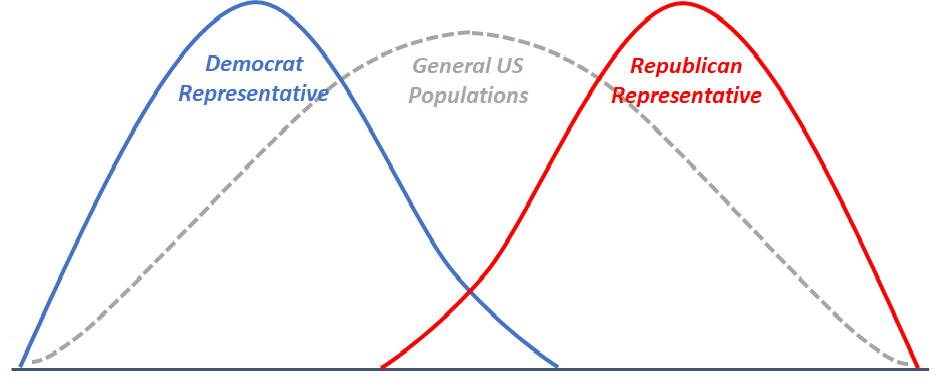THE POLITICAL DIVIDE
In a two-party system, there is a continually a struggle to get a majority in the different branches of the government. Representatives vote on party lines and are often criticized by their own party when they don't. "Bi-lateral support" is a term that is now used when one person from the opposing party crosses party lines to vote and policies that are passed when one party has a unified majority are then over-turned when the other party has control.
The result....... a lack of progress for issues that really matter

Political Parties vs. General Public
The above illustrates the issue with a two-party system. Almost all politicians belong to the Democrat or Republican party and need to get a majority of the vote in their primary. This generally means appealing to a broader base of democrats or republicans including the more extreme voters. Whoever wins the democrat/republican primary often starts to "shift to the middle" to gain independent support in the general election. However, after they win an election they often go back to supporting democrat or republican policies they did in the primary. This is a fundamental disconnect with the general population when voting versus governing.
Why The Divide Matters
Progress. The divide matters because we are too slow, or unable to make necessary changes to address our nation's top issues. Here are a few examples of how making little or no progress plays out:
- Politicians want comprehensive policies that may be polarizing instead of taking bi-partisan steps
- Polarizing policies are made, then removed as parties have unified majorities, then lose them
- Independents or moderates are excluded from the process
How We Fix It
There has, and always will be some sort of political divide. Our objective is to help break some of that political divide by using research to find common ground that politicians, companies and individuals can use to make progress politically, in the community and at the workplace. Our solutions focus on:
- Identifying and quantifying groups based on their beliefs to understand the full spectrum of views
- Understanding the personal beliefs behind why they support/oppose a policy to get to the root cause
- Ensure representatives can vote independently without retaliation from their political party
SIGN UP FOR OUR NEWSLETTER
(Don't worry, we won't flood your inbox)
Thank you for subscribing to our newsletter and reach out if you have questions or to give feedback.
Please try again later
